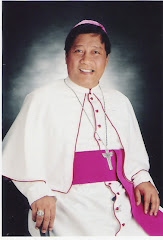 (Shown in this picture on the left is the St. Mary's EPISCOPAL Church otherwise known as the ANGLICAN CHURCH in Poblacion, Sagada)
(Shown in this picture on the left is the St. Mary's EPISCOPAL Church otherwise known as the ANGLICAN CHURCH in Poblacion, Sagada)Early Settlement
About 300 years ago, some Kankanaey folks from the old Lepanto came and settled in Sagada. Biag, an Igorot folklore hero, takes a special role in the founding of Sagada. He organized the people into small kinship communities, introduced rites and prayers to the spirits for which they sacrificed animals. The dap-ay, a special meeting place for the elders, played a significant role in the socio-political and cultural life of these Sagada Igorots.
Through their trading with the Ilocanos in the Western coastlands, the early Igorots of Sagada were introduced to the use of salt, iron, some African and Asian beads, brass gongs and wine jars brought by Chinese traders.
Spanish Period
The fierceness of the Igorots made it difficult for the Spanish colonizers to have an influence on them. Much later in 1892, a Spanish garrison was established in Bontoc which had a minimum presence in Sagada. Just a little later, the Spaniards moved this garrison away to Cervantes. The Catholic missionaries had begun “civilizing” and baptizing local people. But this was short lived when soon the war against the Spanish regime broke out in 1896, followed by that of the Spanish American Revolution in 1898.
American Period
The US forces were stronger than the Filipino resistance. The end of the 19th century saw the rise of American colonialism. Mountain Province was established in 1901 which included Benguet, Ifugao and Kalinga-Apayao which are now all independent provinces.
In 1904, the American John Staunton, an engineer turned Anglican Priest, established the Mission of St. Mary the Virgin in Sagada. His dynamism and vision attempted to make Sagada a center of commerce and Christianity. But due to some internal disputes with the American Episcopal Church, Staunton was forced to leave the Philippines in 1925. Later he would be incorporated to the Roman Catholic Church in 1930, and ordained a Catholic Priest in 1933.
Meanwhile, the Belgian CICM (Congregation of the Immaculate Heart of Mary) missionaries, Frs. Jurgens and Sepulchre, had also arrived in Bontoc in 1907, then proceeded to Bauko. They had established their Catholic Missions in those places leaving Sagada (with the exception of baranggay Kilong which had been an outstation mission under Bontoc) in the good hands of the Episcopal Church.
World War II and After
Sagada was not spared of the heavy damages of the Second World War. Many structures including the St. Mary's Church, built in 1921, were destroyed. In 1942, the Japanese came to Sagada and imprisoned the remaining Americans. After Gen. Yamashita's surrender in 1945, the American teachers and missionaries returned to Sagada and the influence of the Episcopal Church continued.
Today, under the Filipino Episcopal priests, Sagada is still widely Anglican Christian. The Catholic Church has its presence though in two baranggays, namely Kilong (St. Joseph Catholic Church) and Aguid (Our Lady of Lourdes Catholic Chapel) both are under the Sagada Catholic Mission based in Kilong, Sagada.


No comments:
New comments are not allowed.